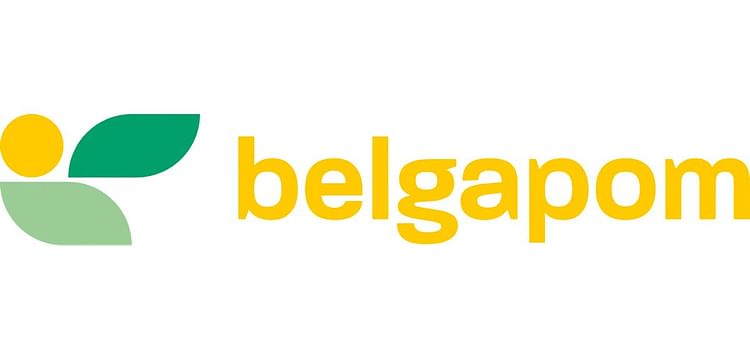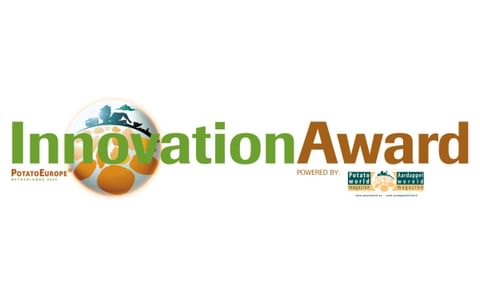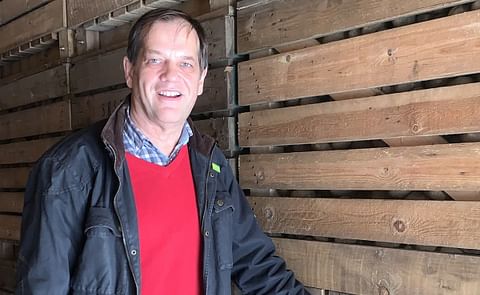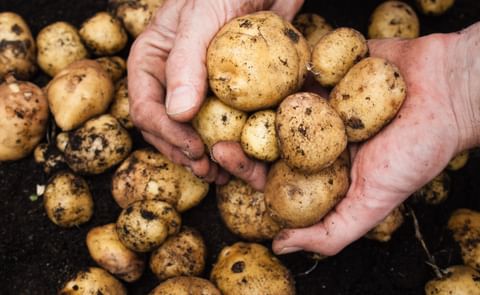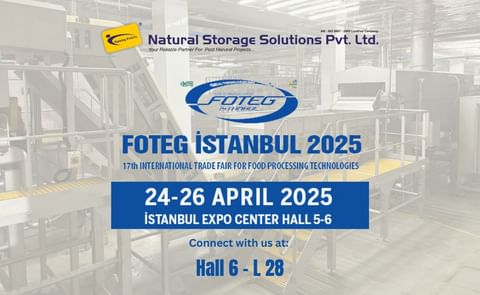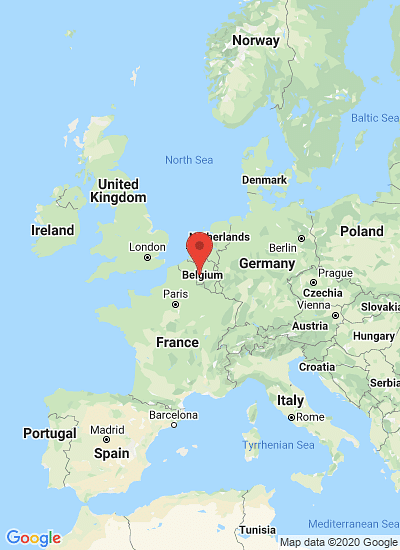An international fair at the heart of the Belgian potato sector.
Potato Europe 2019, an international fair at the heart of the Belgian potato sector.

On 4 and 5 September the international potato fair PotatoEurope 2019 will take place in
Tournai. That the fair continues to grow is demonstrated by the fact that there are almost
20% more exhibitors from 17 different countries.
Surrounded by numerous potato processing
enterprises and in the municipality with the largest potato area in Belgium, we can state that
the fair takes place at the heart of the Belgian potato sector.
The heart of the Belgian potato sector
That the Belgian potato trade and processing can present high growth rates is stating the
obvious. In 2018 the benchmark of 5 million tons processed potatoes was exceeded. In 1990
about 500,000 tons of potatoes were processed into fries, mash products, crisps, flakes and
granules. 28 years later the sector can present an increase of 1000%.
Belgium is the world’s
largest exporter in terms of frozen potato products and delivery takes place in more than
150 countries. Consequently, processing and exporting enterprises such as Lutosa, Mydibel,
Roger & Roger, Agristo, Ecofrost, Clarebout, Pinguin, d’Arta and Westro can be found in the
region of Tournai.
The cluster effect
The fact that this region developed into the worldwide centre for frozen products and
(frozen) potato products in particular, can be reduced to sound basic conditions
complemented by entrepreneurship and a cluster effect.
Firstly, the region enjoys good
climate, soil and agroeconomic conditions to grow potatoes and vegetables. In addition to
this and due to the crisis in the flax industry, starting from the mid-1950s of last century, the
region’s flax industry looked for new opportunities.
Through their entrepreneurship, a
certain amount of industrials reoriented their company on derivates of the flax industry,
such as chipboard, carpet, or upholstery.
From their side, the farmers replaced flax and
other industrial cultivations by intensive vegetable and mushroom cultivations. So in the
mid-1960s the first West-Flemish entrepreneurs ventured into the frozen vegetable market.
Inspired by their successes, they were followed a few years later by other entrepreneurs,
with or without family ties.
At that point, the cluster effect’s flywheel comes into play and
the sector starts growing. In fact, one of the drivers behind the effect is nothing more than
human’s tendency to be better or bigger than the neighbour.
This is how the nearby
competitors levered each other to a higher standard. The tendency to ‘do better than the
neighbour’ was also present at the suppliers and clients, and they grew together with their
buyers.
Moreover, the suppliers who were (by accident already) established in the region
had naturally more market possibilities in the immediate vicinity and hence, also more
opportunities to grow and develop new services.
These, in turn, benefitted their buyers.
Furthermore, there was a network effect ensuring companies could contact each other more
quickly. The role of the government or syndicates which supported these developments by,
for example, establishing research centres, organizing trainings, or by streamlining sales
channels was not unimportant in this regard.
Once the region started to develop as a cluster,
it also attracted companies, employers and investors who saw opportunities in its evolution
and were eager to establish themselves in the region.
This spiral of knowledge, contacts, entrepreneurship and proximity strengthens all
companies in the region and accelerates its sector development. Other examples of clusters
are, for instance, the high-tech companies in San Francisco’s Silicon Valley, the film industry
in Hollywood, the automotive industry in Detroit or the flower bulb cultivation in the
Netherland’s ‘Bulb region’.
Supply of agricultural machinery
Given this cluster effect it is no coincidence that apart from the processing industry, a great
deal of agricultural machinery constructors are established in the region. The two famous
full-liners in agricultural machinery for potato production, AVR and Dewulf are based at not
even 5 kilometers distance from each other in Roeselare, where recently Grimme Belgium
also set up.
Also the manufacturers of sprayers, Beyne and Delvano can be found there.
Manufacturers of agricultural trolleys and soil preparation machinery are also established in
the region.
What concerns the sales of agricultural machinery in Belgium, we can state it follows the
general Belgian tendency. In number, less machines are being purchased by an everdecreasing group of famers, but the sold machines enjoy more capacity and more
possibilities though.
Consequently, more can be done with less and the total capacity can
still be increased. This is clearly reflected in potato harvesters. While in 2011 the lion’s share
of sold harvesters were trailed potato harvesters, those last years the self-propelled 4 rows
harvester has the highest sales success.
Belgium: one for all, all (potatoes) for Belgium
The spectacular growth in potato processing can clearly not only be ascribed to Belgium alone. In this regard we notice that while Belgium still imported 673,940 tons of table potatoes from France in 2009, this number was more than double, 422,554 tons in 2018.
The export of table potatoes from neighbouring country Germany to Belgium also increased from 186,453 tons to 519,540 tons. For the Netherlands we also notice a 30% increase of export to Belgium, amounting to 389,639 tons; but we particularly notice a 84% increase of export from Belgium to the Netherlands, amounting to 660,708 tons in 2018.
Trade, purchase for export through ports and processing is the explanation beyond this. In total, the export of Belgian table potatoes increased by 25% , from 700,086 tons in 2009 to 873,704 tons in 2018, but the Belgian import featured an explosive growth in both relative and absolute figures and nearly doubled from 1,242,075 tons in 2009 to 2,417,030 tons in 2018.
Hence, the trade balance in table potatoes increased from -541,989 in 2009 to - 1,543,326 tons in 2018.
Productions in Belgium
Over the last 10 years, the potato area in Belgium rose by 28%, from 72,723 hectares in 2009 to 93,331 hectares in 2018. The provinces of West Flanders (26%), Hainaut (23%) and East Flanders (13%) together amount for almost 2/3 of the total potato area. On a regional level, the districts of Nivelles (7402 ha), Ypres (6194 ha), Tournai (5223 ha) and Ath (3639 ha) are the frontrunners.

As mentioned before, on a regional level, Tournai also features at the top of the list. That is not illogical since, in terms of surface, Tournai is the biggest municipality in Belgium, and with 16.46% of farmland occupied by potatoes it scores above average. The potato producing municipalities top is completed by Poperinge (1644 ha), Ypres (1507 ha), Heuvelland (1197 ha) and Ath (1166 ha).
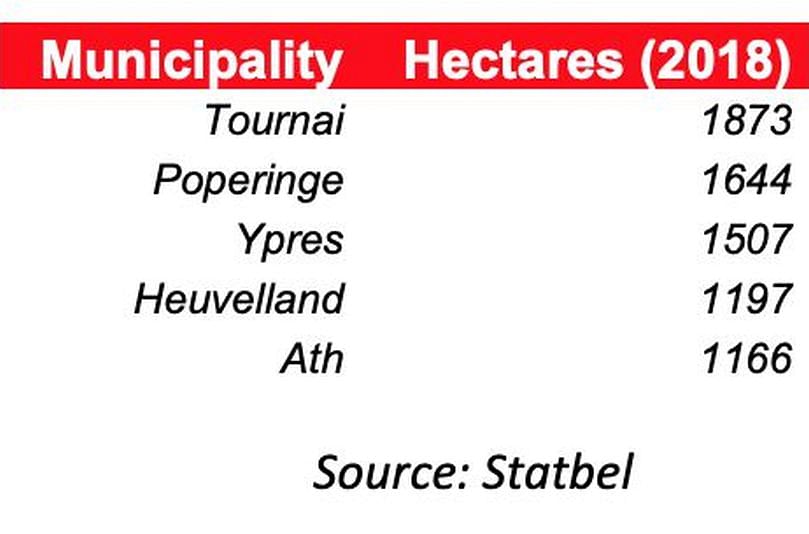
Since almost 90% of the Belgian area is intended for ware potatoes, above-mentioned municipalities also make up the top of the municipalities with the largest ware potato area. The production follows the climatic and soil bound conditions in Belgium.
While the share of first early potatoes in the south of West Flanders does (just) not amount to 20% of the total potato number, in the province of Luxembourg this share accounts for 1%.
The municipalities with the highest % farmland occupied by potatoes, Mesen (29.8%) and Ingelmunster (24.0%) are located within a radius of 50 km around Tournai.
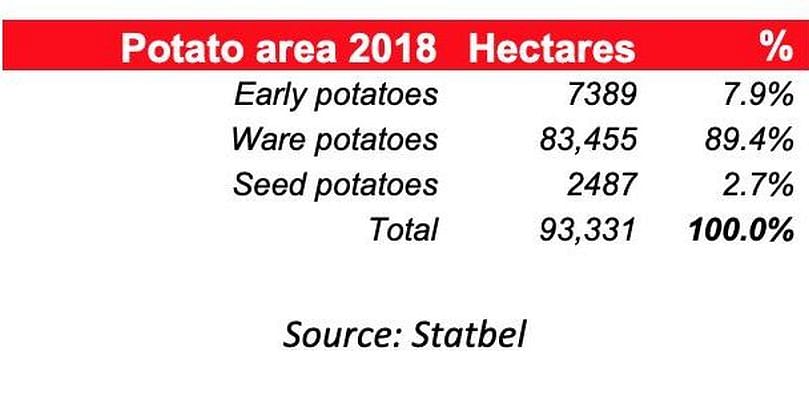
Decrease in the area except in Belgium, the Netherlands and France
In the Europe of 28 Member States, potatoes are grown on 1.7 million hectares. This corresponds to 1.6% of the available and cultivable farmland. In Belgium (11%) and the Netherlands (16%) the share of areas used for the cultivation of potatoes is much higher. In 2018, 52 million tons of potatoes where harvested on these 1.7 million hectares.
This was 37% less than in 2000. In general, the potato area in the EU is shrinking. Over the past 10 years, only Belgium (see above), the Netherlands and France were exceptions to this rule.
In the neighbouring countries the potato area increased especially in France, from 159,315 hectares in 2009 to 200,000 hectares (+26%) in 2018. The Netherlands increased slightly by 6%, from 155,232 hectares in 2009 to 164,973 hectares in 2018.
With 250,200 hectares, Germany remains the biggest European producer, although the area shrunk with -5% since the 263,700 hectares in 2009. Also the UK showed a -3% decrease to 140,000 hectares in 2018.
Nevertheless, the area of these 5 countries together rose by almost 7% between 2009 and 2018. The provisional area figures 2019 show that these five countries total area, continues to increase by 2,4% compared to 2018.

In the neighbouring countries
With 164,973 hectares, the Dutch area is one and a half times larger than the Belgian area. The 4 biggest potato producing provinces in the Netherlands, Drenthe (28,886 ha), Groningen (27,622 ha), Noord-Brabant (21,107 ha) and Zeeland (19,107 ha), represent more than 50% of the total area in the Netherlands.
The other 8 provinces share the remaining area. Only the small and urban province of Utrecht sticks out like a sore thumb with scarcely 104 hectares potatoes.
At a regional level, the 5 municipalities with the largest potato area are Noordoostpolder (9831 ha), Emmen (7428 ha), Borger-Odoorn (5986 ha), Westerwolde (5672) and Hollands Kroon (5132 ha). Noordoostpolder (7313 ha) and Hollands Kroon (4146 ha) mainly grow seed potatoes while Emmen (5682 ha), Borger-Odoorn (5664 ha) and Westerwolde 5202 ha) mainly grow starch potatoes.
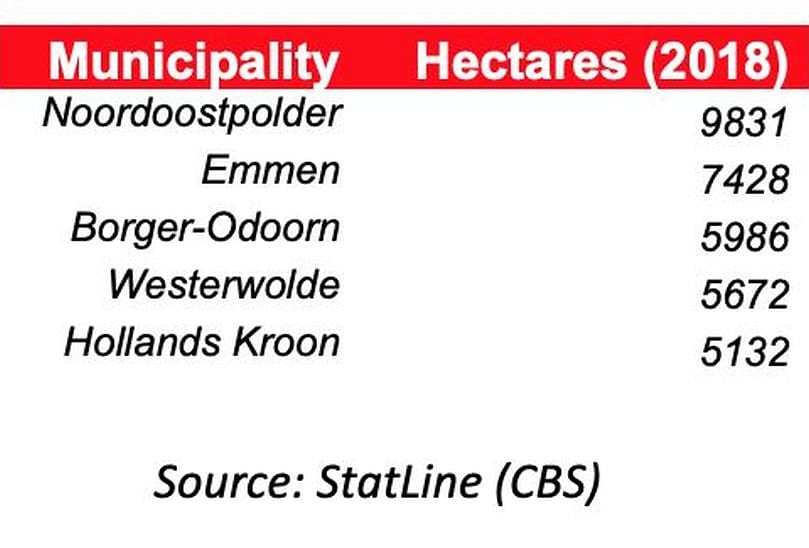
The fact that Noordoostpolder wins the ranking of total cultivation area is not unexpected. On the one hand, it is a large municipality with plenty of available farmland, on the other hand, the region has traditionally been home to many companies active in the (seed) potato sector.
So it does not come as a surprise that this municipality is on top of the list of municipalities with the biggest amount of seed potatoes. Apart from Noordoostpolder and Hollands Kroon, the municipality of Waadhoeke ranks among the top of this list with 3012 hectares seed potatoes,.
With respect to table potatoes, the municipalities GoereeOverflakkee (3566 ha) and Dronte (2432 ha) figure on top of this list. And also here, we can find back Noordoostpolder at the third place, with 2434 hectares.
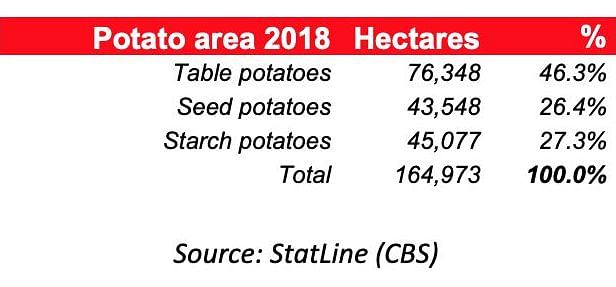
In Germany potatoes are grown on 250,200 hectares. This is 2.7 times more than in Belgium, but Germany is also 11 times bigger than Belgium. The federal state of Lower Saxony (Niedersachsen) accounts for 45% of the area. Number 2, Bavaria follows at a respectable distance with 16% of the area.
The import of table potatoes from Germany to Belgium between 2009 and 2018 increased from 186,453 tons to 519,540 tons. The total production in Germany amounts to 8,747,600 tons (2018).
In France, the regions of Nord-Pas-de-Calais (38%) and Picardie (25%) feature the largest potato areas. It is no coincidence that these regions are close by the centre of gravity of the Belgian potato production and processing. Export from the UK rose, from 5063 tons in 2009 to 28,695 tons in 2019, but these are absolute figures and compared to the other neighbouring countries, so to say negligible.
Small operation areas in Poland and Romania
Another significant European producer is Poland. Although Poland holds the largest potato area of the European Union, due to lower yields and the fact that many small-scale producers are still in operation, the country does not reach the highest production of Europe yet.
The same applies to Romania. In 2016 the entire European Union counted almost 1.5 million agricultural holdings which grow potatoes. With 40% in Romania and 25% in Poland, these two countries consequently account for 2/3 of the European producers. But just 90% of all European producers enjoys an area inferior to 1 hectare.
Hence, the 90% of producers account for no more than 14,8% of the total potato area in Europe. The average Romanian potato grower grows as little as 0.2 hectare potatoes and his Polish colleague no more than 0.8 hectare. Meanwhile, in these countries a group of very large, industrial and agricultural holdings continue to develop though.
Across the spectrum, only 2.2% of the European potato growers had an area superior to 10 hectares in 2016. But with 60.5%, these holdings enjoyed the majority of the European cultivable potato area. With an average of 26.1 hectares, the Danish potato grower is the biggest within Europe. His Dutch and British colleagues share the second place with 16.5 hectares.
Global trade
When it comes to the export of fresh potatoes, Germany remains just ahead of France. At a certain distance, the 3th and 4th place are taken by Belgium and the Netherlands, close to each other. Finally, Egypt ranks 5th.
As to the export of seed potatoes, the Netherlands are the absolute leaders with approximatively five times more export than the second one on the list, France. With regards to frozen potato products, Belgium is the frontrunner, ahead of the Netherlands and Canada. Over the past ten years, Belgium overtook these two countries.




